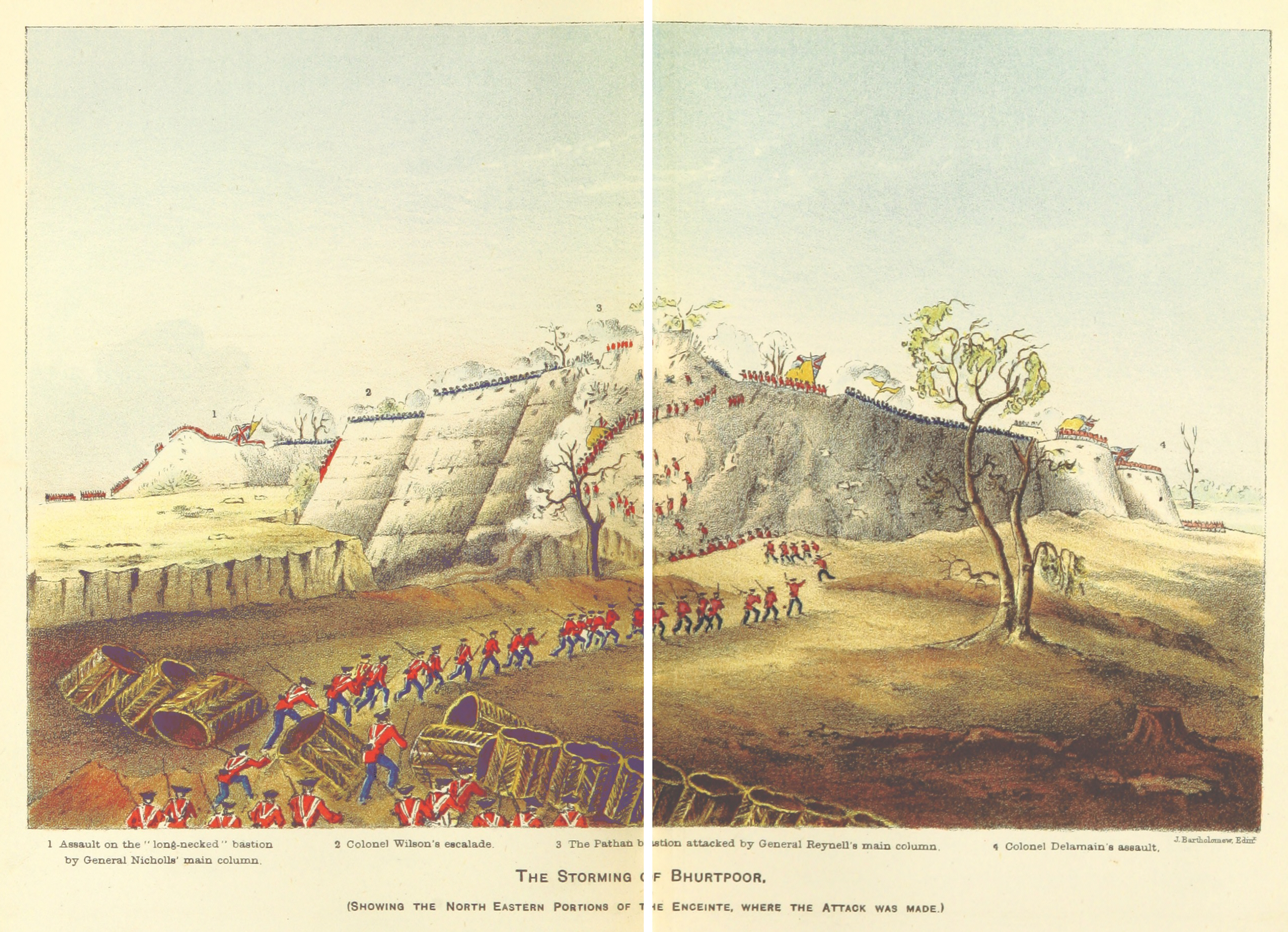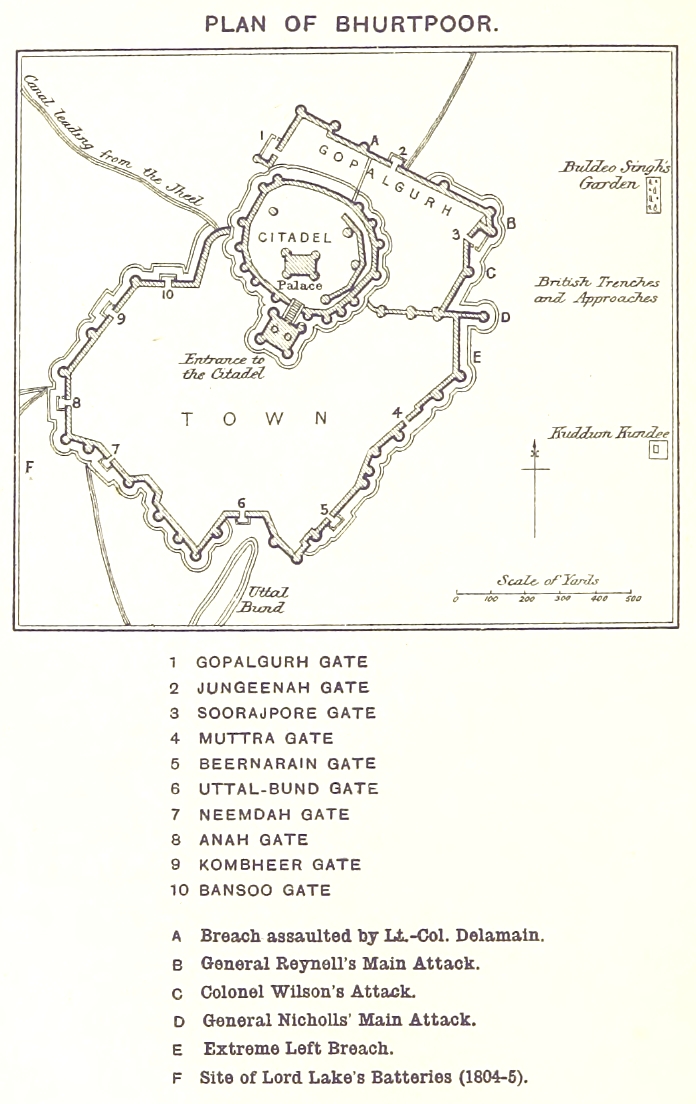Siege of Bharatpur on:
[Wikipedia]
[Google]
[Amazon]

 The siege of Bharatpore was a
The siege of Bharatpore was a

 The siege of Bharatpore was a
The siege of Bharatpore was a siege
A siege is a military blockade of a city, or fortress, with the intent of conquering by attrition, or a well-prepared assault. This derives from la, sedere, lit=to sit. Siege warfare is a form of constant, low-intensity conflict characteriz ...
that took place in the Indian princely state
A princely state (also called native state or Indian state) was a nominally sovereign entity of the British Indian Empire that was not directly governed by the British, but rather by an Indian ruler under a form of indirect rule, subject to ...
of Bharatpur (now part of Rajasthan
Rajasthan (; lit. 'Land of Kings') is a state in northern India. It covers or 10.4 per cent of India's total geographical area. It is the largest Indian state by area and the seventh largest by population. It is on India's northwestern ...
) between December 1825 and January 1826. British troops under Lord Combermere initially surrounded the state's capital until on 18January 1826 its fortress was stormed and captured.
Background
Since theMaratha
The Marathi people ( Marathi: मराठी लोक) or Marathis are an Indo-Aryan ethnolinguistic group who are indigenous to Maharashtra in western India. They natively speak Marathi, an Indo-Aryan language. Maharashtra was formed a ...
sponsored victory at the Siege of Bharatpur in 1805, Bharatpur had remained beyond British control, a situation that unnerved the Court of Directors of the East India Company
The East India Company (EIC) was an English, and later British, joint-stock company founded in 1600 and dissolved in 1874. It was formed to trade in the Indian Ocean region, initially with the East Indies (the Indian subcontinent and Sou ...
(EIC) in London. They met at the beginning of 1825 and sought the advice of the Duke of Wellington
Arthur Wellesley, 1st Duke of Wellington, (1 May 1769 – 14 September 1852) was an Anglo-Irish soldier and Tory statesman who was one of the leading military and political figures of 19th-century Britain, serving twice as prime minister ...
as to how Bharatpur could be taken. He recommended Lord Combermere for the task but was told that the Court did not consider Combermere a "a man of any great genius". "I don't care a damn about his genius," Wellington replied, "I tell you he's the man to take Bhurtpore." Accordingly, Combermere sailed to Calcutta
Kolkata (, or , ; also known as Calcutta , the official name until 2001) is the capital of the Indian state of West Bengal, on the eastern bank of the Hooghly River west of the border with Bangladesh. It is the primary business, commer ...
aboard the EIC ship ''Thalia'' and after a prolonged voyage arrived on 2October 1825.
Meanwhile, the Maharaja
Mahārāja (; also spelled Maharajah, Maharaj) is a Sanskrit title for a "great ruler", "great king" or " high king".
A few ruled states informally called empires, including ruler raja Sri Gupta, founder of the ancient Indian Gupta Empire, a ...
of Bharatpore, Baldeo Singh died in suspicious circumstances to be succeeded by his son Balwant Singh, who was only five years of age but had been officially recognised by the Governor-General of India
The Governor-General of India (1773–1950, from 1858 to 1947 the Viceroy and Governor-General of India, commonly shortened to Viceroy of India) was the representative of the monarch of the United Kingdom and after Indian independence in 1 ...
, Lord Amherst. Before his death Baldeo Singh had entrusted his son to the protection of distinguished General Sir David Ochterlony who, acting on his own initiative as Civil Commissioner, advanced on Bharatpore with an army from the British garrison at Delhi
Delhi, officially the National Capital Territory (NCT) of Delhi, is a city and a union territory of India containing New Delhi, the capital of India. Straddling the Yamuna river, primarily its western or right bank, Delhi shares borders w ...
. When Amherst heard of the move, he sent peremptory orders to recall the troops, whereupon Ochterlony resigned. Amherst then appointed Combermere Commander-in-Chief.
Siege
Combermere's army was made up of two divisions of infantry, one division of regular cavalry, a brigade of irregular horse, a large train of battering ordnance, several brigades of field artillery (horse and foot), along with a corps of engineers, sappers and other requisite troops. The fortress at Bharatpur had been erected by the Jat rulers of Bharatpur and enhanced over the years. By the time Combermere arrived it was in circumference and surrounded by 35 clay and horse dung semi-circular bastions, which had been baked rock-hard by the sun. The fortress was considered impervious to artillery while its defences were enhanced by a wide and deep dry moat, which could be filled by diverting water from a nearby lake. Combermere arrived inAgra
Agra (, ) is a city on the banks of the Yamuna river in the Indian state of Uttar Pradesh, about south-east of the national capital New Delhi and 330 km west of the state capital Lucknow. With a population of roughly 1.6 million, Agra ...
on 1December 1825 and reached Bharatpore on the 10th. On arrival, troops were despatched to capture the reservoir to the north west of the fort to prevent the enemy flooding the area as they had done during the 1805 siege. By the middle of December the fort was surrounded by British forces with skirmishes occurring on a daily basis. The siege continued until the night of 18January when two breaches were made and mines exploded so that within two hours the fort had been stormed and taken.
Aftermath
Following his success at Bharatpur, Lord Combermere was raised in the peerage as Viscount Combermere on 8February 1827. When theprize money
Prize money refers in particular to naval prize money, usually arising in naval warfare, but also in other circumstances. It was a monetary reward paid in accordance with the prize law of a belligerent state to the crew of a ship belonging to ...
was divided following the siege, the officers present gave the sum of £1,000 to the widows of each of the four European officers killed, and £1,000 to be divided amongst the widows and orphans of the European soldiers killed.
For many years the 17.75-ton Bhurtpore gun, captured during the siege stood outside the Royal Artillery Barracks
Royal Artillery Barracks, Woolwich, is a barracks of the British Army which forms part of Woolwich Garrison. The Royal Regiment of Artillery had its headquarters here from 1776 until 2007, when it was moved to Larkhill Garrison.
History
In 17 ...
in Woolwich, London. It is now in the care of the Royal Artillery Museum at Larkhill, Wiltshire.
References
;Bibliography * * * * * * {{coord, 27.2199, 77.4954, display=title History of Bharatpur, Rajasthan Bharatpur Bharatpur 1825 in India 1826 in India Bharatpur December 1825 events January 1826 events